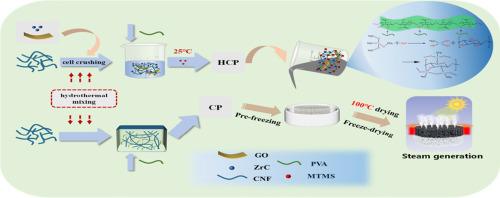Dual-layer cellulose aerogel with integrated zirconium carbide-graphene oxide photothermal system for sustainable solar-driven seawater treatment
IF 12.5
1区 化学
Q1 CHEMISTRY, APPLIED
引用次数: 0
Abstract
Cellulose aerogels combine ultralight weight, high porosity, biodegradability and robust mechanical behavior. However, single component materials such as purely hydrophilic, purely hydrophobic or purely photothermal systems cannot deliver rapid water transport, broad-spectrum solar absorption, effective salt rejection and long-term structural stability at the same time. In this study, we design and fabricate a Janus bilayer aerogel in which the hydrophilic bottom layer consists of cellulose nanofibers (CNFs) and polyvinyl alcohol (PVA) to provide continuous seawater delivery and thermal insulation, while the hydrophobic top layer embeds graphene oxide (GO) together with zirconium carbide (ZrC) to achieve efficient solar absorption from 250 to 2500 nm and rapid heat localization. Optimizing the mass ratio of ZrC to GO at 2 to 1 yields a water evaporation rate of 2.00 kg m−2 h−1 and a solar to vapor conversion efficiency of 94 % under one-sun illumination. The material also resists salt crystallization and regains its mechanical integrity after repeated compression in aqueous environments. This scalable, surfactant-free approach offers a sustainable and cost-effective platform for high-performance solar desalination.

双层纤维素气凝胶,集成碳化锆-氧化石墨烯光热系统,用于可持续太阳能驱动的海水处理
纤维素气凝胶结合了超轻、高孔隙率、可生物降解性和强大的机械性能。然而,纯亲水、纯疏水或纯光热体系等单组分材料无法同时实现快速的水输送、广谱的太阳能吸收、有效的排盐和长期的结构稳定性。在这项研究中,我们设计并制造了一种Janus双层气凝胶,其中亲水的底层由纤维素纳米纤维(CNFs)和聚乙烯醇(PVA)组成,以提供连续的海水输送和隔热,而疏水的顶层嵌入氧化石墨烯(GO)和碳化锆(ZrC),以实现250至2500 nm的高效太阳能吸收和快速热定位。优化ZrC与GO的质量比为2比1,在单太阳照射下,水蒸发率为2.00 kg m−2 h−1,太阳能到水蒸气的转换效率为94%。该材料还可以抵抗盐结晶,并在水环境中反复压缩后恢复其机械完整性。这种可扩展的、无表面活性剂的方法为高性能太阳能海水淡化提供了一个可持续的、具有成本效益的平台。
本文章由计算机程序翻译,如有差异,请以英文原文为准。
求助全文
约1分钟内获得全文
求助全文
来源期刊

Carbohydrate Polymers
化学-高分子科学
CiteScore
22.40
自引率
8.00%
发文量
1286
审稿时长
47 days
期刊介绍:
Carbohydrate Polymers stands as a prominent journal in the glycoscience field, dedicated to exploring and harnessing the potential of polysaccharides with applications spanning bioenergy, bioplastics, biomaterials, biorefining, chemistry, drug delivery, food, health, nanotechnology, packaging, paper, pharmaceuticals, medicine, oil recovery, textiles, tissue engineering, wood, and various aspects of glycoscience.
The journal emphasizes the central role of well-characterized carbohydrate polymers, highlighting their significance as the primary focus rather than a peripheral topic. Each paper must prominently feature at least one named carbohydrate polymer, evident in both citation and title, with a commitment to innovative research that advances scientific knowledge.
 求助内容:
求助内容: 应助结果提醒方式:
应助结果提醒方式:


